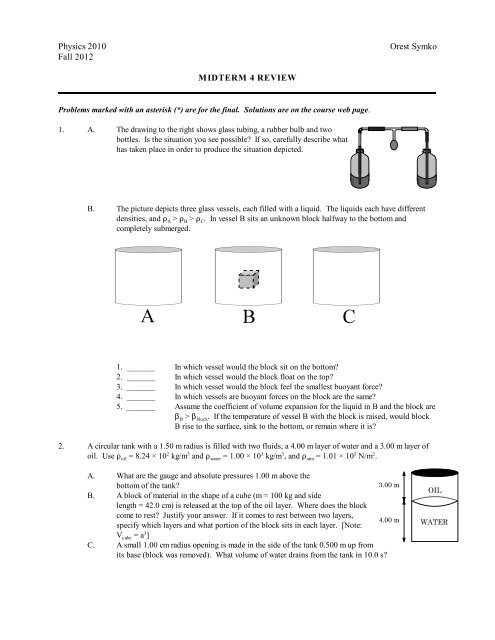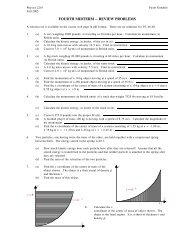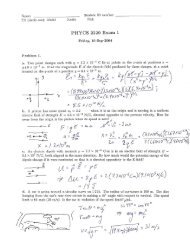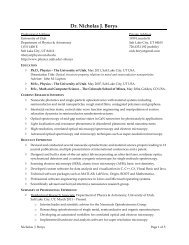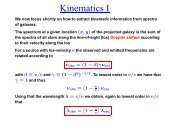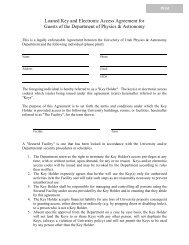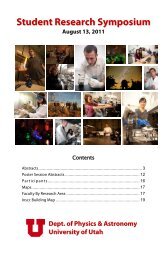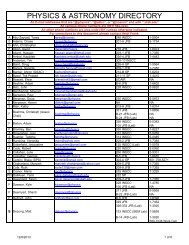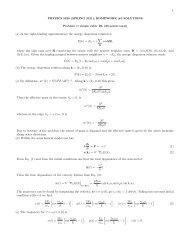Exam 4 Review
Exam 4 Review
Exam 4 Review
Create successful ePaper yourself
Turn your PDF publications into a flip-book with our unique Google optimized e-Paper software.
Physics 2010<br />
Fall 2012<br />
Orest Symko<br />
MIDTERM 4 REVIEW<br />
Problems marked with an asterisk (*) are for the final. Solutions are on the course web page.<br />
1. A. The drawing to the right shows glass tubing, a rubber bulb and two<br />
bottles. Is the situation you see possible? If so, carefully describe what<br />
has taken place in order to produce the situation depicted.<br />
B. The picture depicts three glass vessels, each filled with a liquid. The liquids each have different<br />
densities, and A> B > C. In vessel B sits an unknown block halfway to the bottom and<br />
completely submerged.<br />
1. _______ In which vessel would the block sit on the bottom?<br />
2. _______ In which vessel would the block float on the top?<br />
3. _______ In which vessel would the block feel the smallest buoyant force?<br />
4. _______ In which vessels are buoyant forces on the block are the same?<br />
5. _______ Assume the coefficient of volume expansion for the liquid in B and the block are<br />
B > block. If the temperature of vessel B with the block is raised, would block<br />
B rise to the surface, sink to the bottom, or remain where it is?<br />
2. A circular tank with a 1.50 m radius is filled with two fluids, a 4.00 m layer of water and a 3.00 m layer of<br />
2 3 3 3 5 2<br />
oil. Use = 8.24 × 10 kg/m and = 1.00 × 10 kg/m , and = 1.01 × 10 N/m .<br />
oil water atm<br />
A. What are the gauge and absolute pressures 1.00 m above the<br />
bottom of the tank?<br />
B. A block of material in the shape of a cube (m = 100 kg and side<br />
length = 42.0 cm) is released at the top of the oil layer. Where does the block<br />
come to rest? Justify your answer. If it comes to rest between two layers,<br />
specify which layers and what portion of the block sits in each layer. [Note:<br />
V cube = a 3 ]<br />
C. A small 1.00 cm radius opening is made in the side of the tank 0.500 m up from<br />
its base (block was removed). What volume of water drains from the tank in 10.0 s?
3. A tube is inserted into a vein in the wrist of a patient in a reclined position on a hospital bed. The heart is<br />
vertically 25.0 cm above the position of the wrist where the tube is inserted. Take BLOOD =<br />
3 3 3 2<br />
1.06 × 10 kg/m . The gauge venous blood pressure at the level of the heart is 6.16 × 10 N/m . Assume<br />
blood behaves as an ideal nonviscous fluid.<br />
(a)<br />
(b)<br />
A. What is the gauge venous blood pressure at the position of the wrist?<br />
B. The tube coming from the wrist is connected to a bottle of whole blood the patient needs in a<br />
transfusion. See above figure (b). What is the minimum height above the level of the heart at<br />
which the bottle must be held to deliver the blood to the patient?<br />
C. Suppose the bottle of blood is held 1.00 m above the level of the heart. Assume the tube inserted<br />
in the wrist has a diameter of 2.80 mm. What is the velocity, v, and flow rate of blood as it enters<br />
the wrist. You may also assume the rate at which the blood level in the bottle drops is very small.<br />
The answer you get here is a substantial overstatement. Blood is not really a non-viscous fluid.<br />
4. A 0.500 kg block is attached to a horizontal spring and<br />
oscillates back and forth on a frictionless surface with a<br />
frequency of f = 3.00 hz. The amplitude of this motion is<br />
-2<br />
6.00 × 10 m. Assume t o = 0 and is the instant the block is<br />
at the equilibrium position moving to the left.<br />
A. Write expressions x(t) = A sin (t) and<br />
v(t) = A cos (t) filling in the values of A and .<br />
B. What is the total mechanical energy (ME TOT) of the block-spring system?<br />
C. Suppose the block, at the moment it reaches its maximum velocity to the left splits in half with<br />
only one of the halves remaining attached to the spring. What are the amplitude and frequency of<br />
the resulting oscillations?<br />
D. Suppose, instead of splitting at the position of maximum velocity to the left, the block now splits<br />
when it is at the extreme position in the left. What are the amplitude and frequency of the resulting<br />
motion?<br />
E. Describe in words what would happen to the period of oscillation if a second block identical to the<br />
first block were dropped on the first block at either of its extreme positions.<br />
5. A. A spring has one end attached to a wall and the other<br />
end attached to two identical masses, m Aand m B.<br />
The system is set into oscillation on a frictionless<br />
surface with amplitude A. See figure. When the<br />
system is momentarily at rest at x = -A whatever it is<br />
that holds m Ato m B fails; and later in the motion mB<br />
moves away from m to the right.<br />
A<br />
1. Location where the acceleration of m A is maximum and negative.<br />
2. Location where the KE of m is maximum.<br />
A
The next few questions ask you to compare the behavior of the mass-spring system after and before m B<br />
detached. Energy considerations are most useful here.<br />
3. The amplitude of the mass-spring oscillation has (increased, decreased, not<br />
changed) after m B detaches.<br />
4. The frequency of the mass-spring oscillation has (increased, decreased, stayed<br />
the same) after m B detaches.<br />
5. The maximum speed of m Ahas (increased, decreased, stayed the same) after m<br />
detaches.<br />
6. The period of oscillation of the mass-spring system has<br />
(increased, decreased, stayed the same) after m B detaches.<br />
7. The fraction of the total mechanical energy of the entire spring-2 mass system<br />
carried away with m after m detaches is<br />
B<br />
B. A spherical object is completely immersed in a liquid and is neutrally buoyant some distance above<br />
the bottom of the vessel. See figure. The upper surface of the liquid is open to the<br />
earth's atmosphere.<br />
1. How is the density of the fluid related to the density of the spherical<br />
object?<br />
B<br />
B<br />
2. Assume the fluid and object are incompressible. In addition, the sphere<br />
(coefficient of volume expansion) > liquid. For the following items below,<br />
indicate whether the object sinks to the bottom, rises to the surface, or does<br />
nothing based on the changes described.<br />
a. Atmospheric pressure drops by 20%.<br />
b. Salt is dissolved in the liquid in the same way fresh water is<br />
turned into salt water.<br />
o<br />
c. The entire apparatus is warmed 10 C (liquid and object are<br />
both warmed).<br />
d. The entire apparatus is transported to the surface of the moon.<br />
2<br />
(g moon = 1.6 m/s , P ATM = 0 on moon)<br />
3<br />
e. 100 cm of the liquid is removed from the top. The object is<br />
still initially submerged.<br />
6. A. A mass m is attached to a spring and oscillating on a<br />
frictionless, horizontal surface. See figure. At the instant<br />
the mass passes the equilibrium position moving to the<br />
right, half the mass detaches from the other half. The<br />
oscillating system is now the spring and half the original<br />
mass with the detached mass moving off to the right with<br />
constant velocity. Relative to the original spring-mass system, the new spring-mass system with<br />
half the mass oscillates with ...<br />
In the spaces provided below, enter the words larger, smaller or the same that best completes the<br />
above sentence..<br />
1. amplitude<br />
2. period<br />
3. frequency<br />
4. maximum velocity<br />
5. mechanical energy
B. A solid cylinder is floating at the interface between water and oil with 3/4<br />
of the cylinder in the water region and 1/4 of the cylinder in the oil<br />
region. See figure. Select the item in the parenthesis that best fits the<br />
statement.<br />
1. The item (oil, water, and/or cylinder) with the<br />
largest density.<br />
2. The item (oil, water, and/or cylinder) with the<br />
smallest density.<br />
3. The weight of the cylinder (is equal to, greater<br />
than or less than) the total buoyant force it<br />
feels.<br />
4. The density of the cylinder (is equal to, less<br />
than, or greater than) the density of water.<br />
C.<br />
Three thermometers in different settings record temperatures T 1 = 1000°F, T 2 = 1000°C, and<br />
T 3 = 1000 K. In the space below select T 1, T 2 or T 3, that best fits the statement.<br />
1. The thermometer in the hottest environment.<br />
2. The thermometer in the coolest environment.<br />
3. The thermometer reading a temperature 900° above the boiling point of<br />
water.<br />
3<br />
7. An oil tanker in the shape of a rectangular solid is filled with oil ( oil = 880 kg/m ). The flat bottom of the<br />
hull is 48.0 m wide and sits 26.0 m below the surface of the surrounding water. Inside the hull the oil is<br />
stored to a depth of 24.0 m. The length of the tanker, assumed filled with oil along the entire length, is 280<br />
m.<br />
View from Rear View from Side<br />
3 3<br />
Note: = 1.015 × 10 kg/m ; V = length × width × height.<br />
salt water<br />
rectangular solid<br />
A. At the bottom of the hull, what is the water pressure on the outside and the oil pressure on the<br />
inside of the horizontal bottom part of the hull? Assume the P o above the oil is the same as the Po<br />
5 2<br />
above the water and its value is P o = 1.01 × 10 N/m .<br />
B. If you did part A correctly you determined that the water pressure on the horizontal bottom part of<br />
the hull is larger than the oil pressure there. Explain why this MUST be the case.<br />
C. What buoyant force does the tanker feel?<br />
D. What is the weight of the tanker, excluding the weight of the oil in the hull?
8. A. Water is poured into a tall glass cylinder until it reaches a height of 24.0 cm above the bottom of<br />
3<br />
the cylinder. Next, olive oil ( oil = 920 kg/m ) is very carefully added until the total<br />
amount of fluid reaches 48.0 cm above the bottom of the cylinder. Olive oil and water<br />
do not mix. See figure. Take <br />
3 3<br />
= 1.00 × 10 kg/m and P<br />
5 2<br />
= 1.01 × 10 N/m .<br />
water<br />
1. Indicate on the drawing which layer is water and which is olive oil.<br />
2. What is the gauge pressure 10.0 cm below the top of the upper fluid layer in<br />
the cylinder.<br />
3. What is the gauge pressure on the bottom of the cylinder?<br />
4. If the cylinder is in the shape of a right circular cylinder with radius of 3.60<br />
cm, what force is exerted on the bottom of the cylinder?<br />
B. A 0.200 kg mass is hung from a massless spring. At equilibrium, the spring stretched 28.0 cm<br />
below its unstretched length. This mass is now replaced with a 0.500 kg mass. The 0.500 kg mass<br />
is lowered to the original equilibrium position of the 0.200 kg mass and suddenly released<br />
producing vertical SHM.<br />
1. What is the spring constant for this spring?<br />
2. What is the period of oscillation for the 0.500 kg/spring system?<br />
3. What is the amplitude of this oscillation?<br />
9. The drawing shows a possible design for a thermostat. It consists of an<br />
aluminum rod whose length is 5.00 cm at 20.0°C. The thermostat<br />
switches an air conditioner when the end of the rod just touches the<br />
contact. The position of the contact can be changed with an<br />
adjustment screw. What is the size of the spacing such that the air<br />
conditioner turns on at 27.0°C. This is not a very practical device.<br />
-5<br />
Take = 2.3 × 10 /°C.<br />
al<br />
atm<br />
10. The following is an effective technique for determining the temperature T F inside a furnace. Inside the<br />
furnace is 100 gm of molten (i.e., in a liquid state) lead (Pb). The lead is dropped into an aluminum<br />
calorimeter containing 200 gm water both at an initial temperature of 10.0°C. After equilibrium is reached,<br />
the temperature reads 21.8°C. Assumptions: (1) No water is vaporized; (2) no heat is lost to or gained from<br />
the environment; and (3) the specific heat for the lead is the same whether the lead is a solid or a liquid.<br />
DATA TABLE<br />
LEAD CALORIMETER WATER<br />
m Pb = 100 gm m Al = 150 gm m W = 200 gm<br />
C Pb = 0.0305 cal/gm°C C Al = 0.215 cal/gm°C C W = 1.0 cal/gm°C<br />
L F = 6.0 ca./gm (heat of fusion) T init = 10.0°C T init = 10.0°C<br />
MP Pb = 327°C (melting point)<br />
T F = unknown<br />
T = 21.8°C<br />
equilibrium<br />
A. In words, describe the distinct steps in the cooling of lead.<br />
B. How many calories of heat are absorbed by the calorimeter and the water it contains to reach<br />
21.8°C?<br />
C. How many calories are lost by the lead in cooling from T F to the final equilibrium temperature of<br />
21.8°C?<br />
D. What was the original furnace temperature?<br />
E. If the same amount of aluminum (C Al = 0.215 cal/gm°C and L M = 21.5 cal/gm) were used in the<br />
same furnace instead of lead, would the final equilibrium temperature be higher, less or the same as
in the lead case? No calculation is needed to answer this. Please explain.
11. The length of aluminum cable between consecutive support towers carrying electricity to a large<br />
metropolitan area is 180.00 m on a hot August day when the temperature is 38°C. Use<br />
-6<br />
(Al) = 24 × 10 /°C.<br />
A. What is the length of the same section of aluminum cable on a very cold winter day when<br />
T = -24°C?<br />
-6<br />
B. If the same length of copper ( = 17 × 10 /°C) cable (i.e., 180.00 m on the same hot August day)<br />
were used instead of aluminum, would the length of the copper cable be shorter, longer or the same<br />
as that of the aluminum on the same winter day as in (A)? Please explain your conclusion You do<br />
not have to do any calculations here.<br />
12. You wish to make a cup of coffee with cream in a 0.250 kg mug (c mug = 900 J/kg°C) with 0.325 kg coffee<br />
3 3<br />
(c coffee = 4.18 × 10 J/kg°C) starting at 25.0°C and 0.010 kg cream (c cream = 3.80 × 10 J/kg°C) at 10.0°C.<br />
You use a 50.0 W electric heater to bring the coffee, cream and mug to a final temperature of 90.0°C. How<br />
long must the coffee system be heated? Indicate clearly the assumptions you need to make.<br />
13. A 75.0 kg patient is running a fever of 106°F and is given an alcohol rubdown to lower his body<br />
3<br />
temperature. Take the specific heat of the human body to be C body = 3.48 × 10 J/kg°C, the heat of<br />
5<br />
evaporation of the rubbing alcohol to be L v(alcohol) = 8.51 × 10 J/kg, and the density of the rubbing<br />
3<br />
alcohol to be 793 kg/m . You may assume that all the heat removed from the fevered body goes into<br />
evaporating the alcohol, and that while the patient's body is cooling, his metabolism adds no measurable<br />
heat.<br />
A. What quantity of heat must be removed from the body to lower its temperature to 99.0°F?<br />
B. What volume of rubbing alcohol is required?<br />
C. This is a qualitative question. Give an answer and explanation. Suppose you were told that the<br />
alcohol applied started at room temperature ( 70°F) and were given the specific heat for the<br />
alcohol. Thus, you now expect some of the body heat warming the alcohol to the temperature of<br />
the fever before evaporation occurs. How would this effect the result of the calculation in part (B)?<br />
14. A 56.0 kg hypothermia victim is running a body temperature of 91.0°F. The victim is far away from any<br />
immediate medical treatment. Her friends decide to treat the hypothermia victim by placing the victim in a<br />
sleeping bag with one of her friends and use the heat from the friend to raise the victim's body temperature.<br />
3<br />
Take the specific heat of the human body to be C body = 3.48 × 10 J/kg°C. Assume that the sleeping bag acts<br />
like a perfect calorimeter and also assume no heat is lost to or obtained from the sleeping bag. Finally,<br />
assume all the heat that warms the hypothermia victim comes from the basic metabolic heat produced by the<br />
6<br />
body of the victim's friend in the sleeping bag with her and that metabolism is rated at 2.00 × 10 cal/day,<br />
and that the victim's metabolism is negligible.<br />
A. How much heat must be added to the victim's body to get her temperature up to 98.0°F?<br />
B. How long must the victim remain in the sleeping bag with her friend to achieve this temperature<br />
change?<br />
C. This is a qualitative question. If the thermal characteristics of the sleeping bag are now taken into<br />
account, but still assuming no heat leaves or enters the sleeping bag, how will the answer to<br />
question (b) above be different?<br />
15. A few years back a lawsuit was filed by a woman against McDonald's because she scalded herself with a<br />
Styrofoam cup filled with coffee which she spilled on herself while driving. This question was spawned by<br />
that incredible legal action and represents a possible action taken by McDonald's to insure cooler coffee.<br />
Suppose a typical cup of coffee sold by McDonald's is basically 400 ml of hot water and when poured into<br />
the Styrofoam cup its temperature is 96.0°C. Take 1.00 ml to have a mass of 1.00 gm and = 4.19<br />
kJ/kg°C. Neglect any heat lost to the cup and assume no heat is lost by the coffee to the environment.<br />
A. How much heat in joules must the coffee lose to bring its temperature to a drinkable 68.0°C?<br />
B. McDonald's possible approach to lowering the temperature of the 96.0°C coffee to 68.0°C is to<br />
add a cube of ice initially at 0.0°C. (Take L f = 334 kJ/kg.) What mass of ice has to be added to the<br />
coffee to reduce its initial temperature to the desired 68.0°C?
16. During this past Thanksgiving your instructor overdid it and consumed 3000 Cal of food and dessert.<br />
3<br />
Remember 1.0 Cal = 4.19 x 10 J. For the questions below, assume no heat is lost to the environment.<br />
5 3 o<br />
[Note: = 33.5 x 10 J/kg; = 4.19 x 10 J/kg C]<br />
o<br />
A. If all of this energy went into heating 65.0 kg water starting at 37.0 C (a mass approximately that of<br />
your instructor), what would be the final temperature of this water?<br />
B. Assume your instructor removes these overeating calories by running 10 kilometer races [note:<br />
1.61 km = 1.00 mile]. Using the rule of thumb that 1 mile of jogging will require 100 Cal, what is<br />
the minimum number of races your instructor must run to consume the 3000 Cal in part A as<br />
exercise?<br />
C. The year before, your instructor was particularly gluttonous and consumed 5000 Cal. Assuming<br />
o<br />
the same conditions of water mass (65.0 kg) and starting temperature (37.0 C) as in A, what is the<br />
final temperature of the water system, and if any water vaporizes to steam, how much?<br />
o<br />
[Note: BP(H O) = 100 C]<br />
2<br />
17. Below is the position vs. time graph for the simple harmonic of a spring oscillation on a frictionless<br />
horizontal surface. Motion to the right is positive.<br />
1. The earliest instant of time, including t 0 = 0 at which the PE elastic is maximum.<br />
2. The earliest instant of time at which the KE of the mass is a maximum and the<br />
mass is moving to the right.<br />
3. The earliest instant of time at which the acceleration of the mass is maximum and<br />
positive.<br />
4. The earliest instant of time at which the speed of the mass is zero.<br />
18. A. A spring is attached to a post at the top of a 15.0° frictionless<br />
ramp. A 2.00 kg mass is attached to the spring and the mass is<br />
slowly allowed to stretch the spring to the equilibrium position<br />
of the mass-spring system, the spring stretches by 0.400 m See<br />
figure. The mass is now pulled an additional 10.0 cm and<br />
released. The mass-spring system executes simple harmonic<br />
motion.<br />
1. What is the spring constant, k, of the spring.<br />
2. What are the amplitude and period of oscillation of the mass-spring system?<br />
B. A solid, uniform cylinder is floating at the interface between water ( water = 1.00 × 10 3<br />
3 3 3<br />
kg/m ) and oil ( oil = 8.24 × 10 kg/m ) with 3/4 of the cylinder in the water region and<br />
1/4 of the cylinder in the oil region. Assume the axis of the cylinder is perfectly<br />
vertical. See figure.<br />
1. What is the density of the material out of which the cylinder is made?<br />
2. Assume the upper surface of the oil region si open to the atmosphere<br />
5 2<br />
( atm = 1.01 × 10 N/m ) and the oil-water interface is 0.500 m below the<br />
upper surface of the oil. Also assume the height of the cylinder is 10.0 cm.<br />
What is the gauge pressure on the bottom surface of the cylinder? Recall:<br />
P = P - P .<br />
gauge<br />
ATM
19. A. A mass m is attached to a spring and is oscillating on a frictionless horizontal surface (see figure).<br />
At the instant the mass is at an amplitude position a second identical mass is carefully placed on<br />
top of the original mass. The oscillating system is now the spring and the two identical masses.<br />
Relative to the original spring-single mass system, the new spring-2-mass system oscillates with<br />
a ... In the spaces provided below, enter (I) for increased, (D) for decreased, or (R) remains<br />
unchanged, that best completes the above last sentence.<br />
1. amplitude.<br />
2. period.<br />
3. frequency.<br />
4. spring constant.<br />
5. maximum speed.<br />
6. mechanical energy.<br />
7. maximum acceleration.<br />
B. Suppose you are asked about the absolute pressure at some depth h below the surface of a liquid.<br />
The top surface is exposed to the atmosphere on a sunny day in Salt Lake City. For each statement<br />
below in the spaces provided, enter I for increase, D for decrease, or R for remains the same, when<br />
accounting for what happens to the absolute pressure at the point you are observing.<br />
1. More liquid is added so now the observation point is farther below the surface.<br />
2. The fluid is now exchanged for a less dense fluid. The observation point is at<br />
same h.<br />
3. The experiment is moved to New York City, which is at sea level, on a sunny<br />
day.<br />
4. The fluid is now seen to be moving with some speed v past the observation point.<br />
5. The observation point is moved closer to the surface of the liquid.<br />
6. The air above the fluid is removed by a vacuum system.<br />
7. The apparatus is moved to a laboratory on the surface of the moon.<br />
20. A 3.00 kg mass is attached to a spring (k = 52.0 N/m) that is hanging vertically from a fixed support. The<br />
mass is moved to a position 0.800 m lower than the unstretched position of the end of the spring. The<br />
spring is then released and the mass-spring system executes SHM. Take the 0.800 m of the mass as the<br />
reference location for its gravitational PE.<br />
A. What is the equilibrium position of the mass-spring system?<br />
B. What is the amplitude of the SHM the mass-spring system executes?<br />
C. What is the period of the oscillation of this system?<br />
D. What is the total mechanical energy of the mass-spring system at the moment the mass is released?<br />
E. What are (i) the KE of the mass and (ii) the speed of the mass when the spring is at its equilibrium<br />
position?<br />
21. A 38.0 kg block is moving back and forth on a frictionless horizontal<br />
surface between two springs. The spring on the right has a force<br />
3<br />
constant k R = 2.50 × 10 N/m. When the block is between the two<br />
springs its speed (v) is 1.82 m/s. See figure.<br />
A. If the block compresses the left spring to 5.62 cm beyond its uncompressed length, determine the<br />
value of k L.<br />
B. What is the maximum compression of the right spring when the mass interacts with it?<br />
C. What is the total time the spring on the right is compressed during a single event?
22. Two identical containers are connected at the bottom via a tube of<br />
negligible volume and a valve which is closed. Both containers<br />
are filled initially to the same height of 1.00 m, one with<br />
3<br />
chloroform ( C = 1530 kg/m ) in the left chamber and the other<br />
4 3<br />
with mercury in the right chamber ( Hg = 1.36 × 10 kg/m ).<br />
Sitting on top of each identical circular container is a massless<br />
plate that can slide up or down without friction and without<br />
allowing any fluid to leak past. The radius of the circular plate is<br />
12.0 cm. The valve is now opened.<br />
A. What volume of mercury drains into the chloroform<br />
2<br />
container? (Note: V cyl = r h)<br />
B. What mass must be placed on the plate on the chloroform side to force all the mercury, but none of<br />
the chloroform, back to the mercury chamber?<br />
23. A 12.0 kg mass M is attached to a cord that is wrapped around a wheel in the<br />
shape of a uniform disk of radius r = 12.0 cm and mass m = 10.0 kg. The block<br />
starts from rest and accelerates down the frictionless incline with constant<br />
2<br />
acceleration. Assume the disk axle is frictionless. Note: I = 1/2 mr .<br />
A. Use energy methods to find the velocity of the block after it has moved<br />
2.00 m down the incline.<br />
B. What is the constant acceleration of the block and the angular<br />
acceleration of the wheel?<br />
C. How many revolutions does the wheel turn for the distance the block travels in (A)?<br />
D. If the uniform disk were replaced by a uniform sphere with the same r and m of the disk, would the<br />
acceleration of the block attached to the sphere be larger, smaller, or the same as that for the block<br />
attached to the disk? Note: I<br />
2<br />
= 2/5 mr .<br />
sphere<br />
24. A pulley is in the shape of a uniform disk of mass m = 5.00 kg and radius r = 6.40 cm. The<br />
pulley can rotate without friction about an axis through the center of mass. A massless cord is<br />
wrapped around the pulley and connected to a 1.80 kg mass. The 1.80 kg mass is released from<br />
2<br />
rest and falls 1.50 m. See figure. Note: I = 1/2 mr .<br />
disk<br />
A. Use energy methods to determine the speed of the block after falling 1.50 m.<br />
B. What is the constant acceleration of the block and the angular acceleration of the<br />
wheel?<br />
C. How many revolutions does the pulley disk turn for the distance the block travels in<br />
(A)?<br />
D Suppose the disk were replaced by a uniform sphere with the same r and m of the disk.<br />
Would the acceleration of the block attached to the sphere be larger, smaller, or the same as that for<br />
2<br />
the block attached to the the disk? Note: I 2/5 mr .<br />
26. A 75.0 kg sign hangs from a 4.80 m uniform horizontal rod whose mass<br />
is 120 kg. The rod is supported by a cable that makes an angle of 53°<br />
with the rod. he sign hangs 3.60 m out along the rod.<br />
sphere<br />
A. What is the tension in the cable?<br />
B. What are the forces P vand P H exerted by the wall on the left<br />
end of the rod?<br />
disk
4<br />
27. A 1.00 × 10 N great white shark is hanging by a cable attached to a 4.00 m massless<br />
rod<br />
that can pivot at its base. See figure.<br />
A. Determine the tension in the cable supporting the upper end of the rod. See<br />
figure.<br />
B. Determine the force (a vector quantity) exerted on the base of the rod.<br />
Suggestion: Find this force by first evaluating the separate components of<br />
the force. See figure.<br />
28. A 6.00 m uniform beam extends horizontally from a hinge fixed on a<br />
wall on the left. A cable is attached to the right end of the beam.<br />
The cable makes an angle of 30.0° with respect to the horizontal and<br />
the right end of the cable is fixed to a wall on the right. At the right<br />
end of the cable hangs a 140.0 kg mass. The mass of the beam is<br />
240.0 kg. See figure.<br />
A. Find the tension in the cable.<br />
B. Find the vertical and horizontal forces the hinge exerts on<br />
the left end of the beam.<br />
29. A. The blades of a “Cuisinart” blender when run at the “mix” level, start from rest and reach 2.00 ×<br />
3<br />
10 rpm (revolutions per minute) in 1.60 s. The edges of the blades are 3.10 cm from the center of<br />
the circle about which they rotate.<br />
1.<br />
2<br />
What is the angular acceleration of the blades in rad/s while they are accelerating?<br />
2. Through how many rotations did the blades travel in that 1.60 s?<br />
3.<br />
-5 2<br />
If the blades have a moment of inertia of 5.00 × 10 kg m , what net torque did the blades<br />
feel while accelerating?
4<br />
B. A 7.50 × 10 N shipping crate is hanging by a cable attached to a uniform<br />
4<br />
1.20 × 10 N steel beam that can pivot at its base. A second cable supports<br />
the beam and is attached to a wall. See figure.<br />
1. Determine the tension T in the upper cable.<br />
2. Determine the magnitude of the force exerted on the beam at its<br />
base. See drawing.<br />
30. The drawing shows a uniform ladder of length L and weight 220 N. The<br />
ladder is sitting at an angle of 30° above the horizontal resting on the<br />
corner of a concrete wall at a point that is one-fourth of the way from the<br />
end of the ladder. A 640 N construction worker is standing on the ladder<br />
one-third of the way up from the end of the ladder which is resting on the<br />
ground. Assume the corner of the wall on which the ladder rests exerts<br />
only a normal force on the ladder at the point where there is contact.<br />
A. What is the magnitude of the normal force the wall exerts on the<br />
ladder?<br />
B. Find the magnitude of both the normal force the ground exerts on the left end of the ladder and the<br />
static frictional force the ground exerts on the left end of the ladder.<br />
31. A. A solid, right circular cylinder (radius = 0.150 m, height = 0.120 m)<br />
has a mass m. The cylinder is floating in a tank in the interface<br />
between two liquids that do not mix: water on the bottom and oil<br />
above. One-third of the cylinder is in the oil layer ( oil = 725 kg/m )<br />
3 3<br />
and two-thirds in the water layer ( water = 1.00 × 10 kg/m ). See<br />
2<br />
drawing. Note: V(circular cylinder) = rh.<br />
1. Find the mass of the cylinder.<br />
2. With the cylinder present, take the thickness of the oil layer<br />
to be 0.200 m and the thickness of the water layer to be 0.300 m. What is the gauge<br />
pressure at the bottom of the tank? Assume the top of the oil layer is exposed to the<br />
atmosphere.<br />
B. A block rests on a frictionless horizontal surface and is attached<br />
to a spring. When set into simple harmonic motion, the block<br />
oscillates back and forth with an angular frequency of = 7.52<br />
rad/s. The drawing indicates the position of the block when the<br />
spring is unstretched. That position is labeled “x = 0 m” in the<br />
drawing. The drawing also shows a small bottle whose left edge is<br />
located at X b = 0.0900 m. The block is now pulled to the right,<br />
stretching the spring by X s = 0.0343 m, and is then thrown to the<br />
left, i.e., given an initial push to the left. In order for the block to<br />
knock over the bottle when it is moving to the right, it must be “thrown” with an initial speed to the<br />
left v . Ignoring the width of the block, what is the minimum value of v ?<br />
0 0
2 2 2<br />
32. B. Three objects, a disk (I CM = ½ MR ), a hoop (I CM = MR ), and a hollow ball (I CM = b MR ) all<br />
have the same mass and radius. Each is subject to the same uniform tangential force that causes the<br />
object, starting from rest, to rotate with increasing angular speed about an axis through the center<br />
of mass for each object. In the case of the hollow ball the tangential force has a moment arm equal<br />
to the radius of the ball. In the space below, enter D for disk, H for hoop, and/or B for hollow ball,<br />
or same to best answer the question.<br />
1. The object with the largest moment of inertia about the axis through the CM.<br />
2. The object experiencing the greatest net torque.<br />
3. The object with the greatest angular acceleration during the period the force is<br />
acting.<br />
4. The object rotating with the smallest angular speed assuming the force has been<br />
acting for the same length of time on each object.<br />
33. A. A uniform disk (D), hoop (H), and sphere (S), all with the same mass and radius, can freely rotate<br />
about an axis through the center of mass (CM) of each. A massless string is wrapped around each<br />
item. The string is used to apply a constant and equal tangential force to each object. See figure.<br />
For the statements below, enter D, H, S, none or the same. Assume all objects start from rest at the<br />
same instant.<br />
1. The one with the smallest moment of inertia about the shown axis.<br />
2. The object experiencing the largest net torque.<br />
3. The object undergoing the smallest angular acceleration.<br />
4. The object with the largest angular speed after an elapsed time of 5.0 s.<br />
5. The object for which the largest amount of string has unraveled in 5.0 s.<br />
6. The object with the smallest KE rot after 5.0 s.<br />
7. The object that undergoes the most rotations in 5.0 s.<br />
B. A spherical object is completely immersed in a liquid of density liq some distance<br />
above the bottom of the vessel. See figure. The upper surface is initially open to the<br />
earth’s atmosphere at sea level. Assume the liquid and object are both incompressible.<br />
For the items below, indicate whether the object sinks to the bottom (B), rises to the<br />
surface (T), or does nothing (N).<br />
1. The vessel is brought to Salt Lake City.<br />
2. Salt is dissolved in the liquid in the same way fresh water is turned<br />
into salt water.<br />
3.<br />
3<br />
The top 50 cm of the liquid is removed from the vessel.<br />
4. The entire apparatus is transported to the surface of the moon.<br />
5. The volume of the spherical object is increased by heating it without heating the<br />
liquid.<br />
6. The spherical object is moved 10 cm farther down in the vessel and released.<br />
7. A mass is placed on the top surface of the liquid in the vessel increasing the<br />
pressure at the surface. No fluid leaks.
3<br />
34. A 2.20 × 10 N uniform beam is attached to an overhead beam as<br />
3<br />
shown in the drawing. A 3.60 × 10 N trunk hangs from an<br />
attachment to the beam two-thirds of the way down from the<br />
upper connection of the beam to the overhead support. A cable is<br />
tied to the lower end of the beam and is also attached to the wall<br />
on the right.<br />
A. What is the tension in the cable connecting the lower end<br />
of the beam to the wall?<br />
B. What are magnitude of the vertical and horizontal<br />
components of the force the overhead beam exerts on the<br />
upper end of the beam at P?<br />
35. A. A 12.0 kg block moves back and forth on a frictionless horizontal surface between two springs.<br />
The spring on the right has a force constant k = 825 N/m.<br />
When the block arrives at the spring on the right, it<br />
compresses that spring 0.180 m from its unstretched position.<br />
1. What is the total mechanical energy of the block and<br />
two spring system?<br />
2. With what speed does the block travel between the two springs while not in contact with<br />
either spring?<br />
3. Suppose the block, after arriving at the left spring, remains in contact with that spring for<br />
a total time of 0.650 s, before separating on its way to the right spring? Using the<br />
connection between this 0.650 s and the period of oscillation between the block and the<br />
left spring, determine the spring constant of the left spring.<br />
B. A turkey baster (see figure) consists of a squeeze bulb attached to a plastic tube.<br />
When the bulb is squeezed and released, with the open end of the tube under<br />
the surface of the turkey gravy, the gravy rises in the tube to a distance h, as<br />
shown in the drawing. It can then be squirted over the turkey. Using P atm =<br />
5 2 3 3<br />
1.013 × 10 N/m for atmospheric pressure and 1.10 × 10 kg/m for the density<br />
of the gravy, determine the absolute pressure of the air in the bulb with the<br />
distance h = 0.160 m. Give answer to three significant digits.<br />
36. A. The pictures below depict three glass vessels, each filled with a liquid. The liquids each have<br />
different densities, and A> B > C. In vessel C an unknown block is neutrally buoyant halfway<br />
to the bottom and completely submerged.<br />
A, B, and/or C, or none are all possible answers.<br />
1. _______ In which vessel(s) would the block sink all the way to the bottom?<br />
2. _______ In which vessel(s) would the largest volume of the block be exposed above the<br />
surface of the liquid?<br />
3. _______ In which vessel(s) would the buoyant forces on the block be the same?
B. A swinging pendulum (A) and a mass-spring system (B) are built to have identical periods. For the<br />
statements below enter either A, B, U (unchanged) to best fit which oscillating system would have<br />
the larger period as a result of the change.<br />
1. _______ The mass of the mass-spring system is increased.<br />
2. _______ The mass of the swinging pendulum is increased without altering the location of<br />
its center of mass.<br />
3. _______ The spring constant of the mass-spring system is increased.<br />
4. _______ The length of the swinging pendulum system is increased.<br />
5. _______ Both systems are taken to the moon and set oscillating.<br />
C. A block of mass m moves back and forth on a frictionless surface<br />
between two springs. See drawing. Assume k L > k R. For the<br />
statements below enter L for the left spring, R for the right spring,<br />
or same as the case may be.<br />
1. _______ The spring that has the maximum compression when m is momentarily at rest.<br />
2. _______ The spring that stores the larger elastic potential energy when maximally<br />
compressed.<br />
3. _______ The spring that momentarily stops the block in the least time once the block<br />
arrives at the spring.<br />
37. A uniform beam extending at right angles from a wall is used to display an<br />
advertising sign for an eatery. The beam is 2.50 m long an weighs 80.0 N. The sign,<br />
whose dimensions are 1.00 m by 0.800 m, is uniform, and weighs 200. N, hangs from<br />
the beam as shown in the drawing. A cable, attached to the wall of the eatery at a<br />
point on the beam where the inside end of the sign is attached to the beam and<br />
making an angle of 60.0° with the beam, supports this advertising structure.<br />
A. What is the magnitude of the tension in the cable supporting the beam?<br />
B. What are the magnitudes of the horizontal and vertical forces the wall exerts<br />
on the left end of the beam?<br />
38. A. <strong>Exam</strong>ine the picture shown to the right. Initially, before the pump is<br />
turned on, the two masses (m 1 = 1.00 kg, m 2 = 2.75 kg) are held in<br />
5 2<br />
place. the pressures above and below m 1 are P atm = 1.01 × 10 N/m and<br />
the spring is in its unstretched position. The pump is turned on and the<br />
masses are allowed to move. The mass m 1 moves without friction inside<br />
a cylindrical piston of radius r = 3.85 cm. Once equilibrium is<br />
established, by what distance has the spring stretched? Take k =<br />
3<br />
2.00 × 10 N/m for the spring constant.<br />
B. A solid cylinder (radius 0.125 m and height 0.150 m) has a mass of 6.50 kg. The<br />
3<br />
cylinder is floating in water. Oil ( oil = 725 kg/m ) is poured on top of the water until<br />
the situation shown in the drawing results. How much of the height (in meters) of the<br />
cylinder remains in the water layer?


